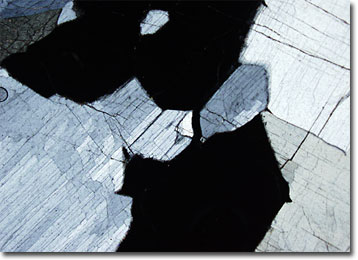Polarized Light Microscopy Digital Image Gallery
Garnet Wollastonite Skarn
The term skarn was originally coined in Sweden to refer to iron deposits that occur in rocks bordering an igneous intrusion, but today it is more generally used for pluton-neighboring rocks containing any type of ore. Among the minerals commonly found in skarns are garnets and calc-silicates, such as wollastonite.

View a second image of Garnet Wollastonite Skarn
Garnets are a group of silicate minerals that are common in many parts of the world, frequently occurring as well-developed crystals. This fact, along with their availability in a wide array of colors, contributes to their widespread popularity as gemstones. The best-known varieties of garnet utilized for such purposes are almandine, which exhibits deep violet-red hues, and pryope, which is prized for its ruby-red color. Garnets are not only valued, however, for their beauty, but also for their considerable hardness, which makes them useful as abrasives.
Similar to garnet, wollastonite is a silicate mineral fairly widespread in its distribution. It was named in honor of the English scientist William Hyde Wollaston, who, in addition to his important discovery of dark lines in the solar spectrum and other notable achievements, created an endowment to be granted annually by the Geological Society of London. Wollastonite crystals typically appear glassy white, but may occasionally be found in shades of gray. The mineral is most commonly utilized in ceramics and paints.
